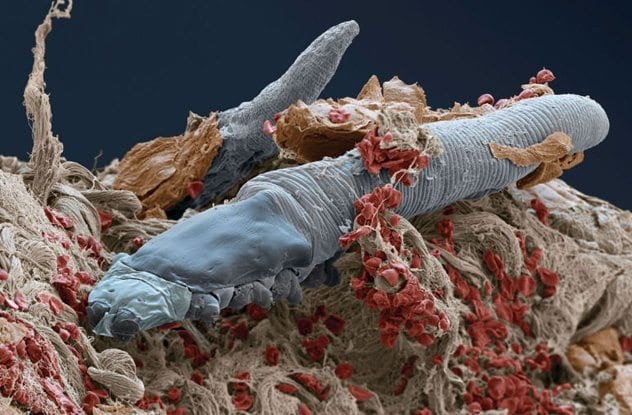 Weird Stuff
Weird Stuff  Weird Stuff
Weird Stuff  Mysteries
Mysteries 10 Tragic Disappearances and Deaths in Joshua Tree National Park
 History
History 10 Ways Childhood Really Sucked in the Old West
 Music
Music 10 Name Origins of Famous Bands from the 1990s
 Religion
Religion 10 Biggest Turnarounds by the Catholic Church
 Weird Stuff
Weird Stuff 10 Unbelievable Times Laws Had Unintended Consequences
 Humans
Humans Ten Historic Women Who Deserve Way More Credit Than They Got
 Movies and TV
Movies and TV 10 Films That Spawned Major Lawsuits
 History
History Ten Times Towns Were Wiped Off the Face of the Earth
 Creepy
Creepy 10 of the Most Disturbingly Haunted Public Houses in the UK
 Weird Stuff
Weird Stuff 10 Niche Subcultures That Are More Popular Than You Might Think
 Mysteries
Mysteries 10 Tragic Disappearances and Deaths in Joshua Tree National Park
 History
History 10 Ways Childhood Really Sucked in the Old West
Who's Behind Listverse?

Jamie Frater
Head Editor
Jamie founded Listverse due to an insatiable desire to share fascinating, obscure, and bizarre facts. He has been a guest speaker on numerous national radio and television stations and is a five time published author.
More About Us Music
Music 10 Name Origins of Famous Bands from the 1990s
 Religion
Religion 10 Biggest Turnarounds by the Catholic Church
 Weird Stuff
Weird Stuff 10 Unbelievable Times Laws Had Unintended Consequences
 Humans
Humans Ten Historic Women Who Deserve Way More Credit Than They Got
 Movies and TV
Movies and TV 10 Films That Spawned Major Lawsuits
 History
History Ten Times Towns Were Wiped Off the Face of the Earth
 Creepy
Creepy 10 of the Most Disturbingly Haunted Public Houses in the UK
10 Places You Would Never Expect To Find Bacteria
Humans share the Earth with a plethora of different bacteria, distant relatives of ours who inhabit a variety of different environments and perform countless functions—some of which we welcome, and some of which we fight against. It could be said, however, that it is the bacteria who are nice enough to share the Earth with us, considering there are roughly 5×10^30 bacteria on the planet—forming a total mass greater than that of all plants and animals combined.
We tend to think of them existing only in places where other life forms can be found, such as in our gut, the kitchen, forests, and ponds. However, plenty of bacteria require no such environment and can be found in some truly obscure and surprising places on this planet and beyond.
10Inside Solid Rock

It was long believed that one of the requirements for life to exist was sunlight. Even organisms not directly exposed to the Sun (such as those residing in your gut) would consume organic matter that at one point was synthesized with the help of sunlight.
Recently, however, this dogma has been called into question. A team of scientists investigating a South African gold mine has discovered bacteria over 1.5 miles below the ground that seem to subsist purely off of radioactive waste.
The uranium, thorium, and potassium in the surrounding rock formation seem to have just the right amount of energy to break down water molecules, which leads to the production of hydrogen peroxide and sulfates. The radiation breaks down the water molecules into two atoms of hydrogen and a single atom of oxygen, which combine with other water molecules to form hydrogen peroxide. The hydrogen peroxide then reacts with pyrite (fool’s gold) to produce sulfate ions, which the bacteria feast upon with great relish.
And these lonely microbes seem to be in no rush to leave their rocky fortress. Whereas much of the bacteria we encounter on a daily basis—such as E. coli—divides almost daily, this rock-dwelling bacteria is estimated to divide between once a year and once every 300 years.
9The Cleanest Place On Earth: Nasa ‘Clean Rooms’

If you have ever given your kitchen or bathroom a thorough cleaning, you doubtless have walked away with a feeling of satisfaction, knowing that any living microbes that once were there have been eviscerated. Now imagine you work for NASA, and your job is to make the “clean rooms” (where everyone is required to walk around in triple-layer, sterilized body suits) as clean as possible. And NASA wants them really clean.
These rooms are what “hospital operating rooms are to patients,” says Mike Weiss, Hubble’s technical deputy program manager at Goddard. “Surgeons wear sterile gowns, gloves and masks during surgery, and operating rooms must be kept free of germs to keep patients healthy. In our case, [the spacecraft] is the patient.”
Anyone who enters must pass through a series of “lobbies,” the first of which contains special adhesive to remove dirt particles from shoes, the second of which provides a high-pressure air shower, and the third of which forces you to cover yourself from head to toe in protective clothing.
This painstaking procedure made it all the more upsetting when an entirely new genus of bacteria was discovered in not one, but two NASA clean rooms. Named Tersicoccus phoenicis (“Tersi” is Latin for clean), this bacterium has earned a reputation for outwitting the most intense industrial cleaners and sterilization techniques.
Scientists at NASA make sure to keep samples of this resilient creature on hand to compare it to any potential bacteria brought back from space.
8Sheets Of Ice

When we think of ice, we inevitably think of cold, which brings with it very little movement and therefore very little life. The freezer is where we put food for long-term storage not because we necessarily want to make more room in the refrigerator but because we want to slow down the various chemical processes that will cause the food to spoil.
This is why it is all the more surprising that large populations of bacteria have found a long-term home in some of the world’s largest glaciers—with some bacterial strains lasting for millions of years.
The Transantarctic Mountains in Antarctica contain the oldest known ice on Earth and are home to microbes that have lived there for millions of years. It is estimated that the entire microbial cell population encased in the ice sheets of Antarctica outnumber the human population of Earth more than 10,000 times over.
And now that the Earth is warming and the ice is melting, these little guys may soon be liberated into the ocean, where they will have to adapt to an unfamiliar but perhaps more hospitable environment.
7Boiling Water

Every boy scout knows that if you come across a natural source of water, the water must be boiled before consumption to remove any harmful bacteria. Be careful, however, the next time you take solace in this technique, since some bacteria, such as Clostridium botulinum, can survive in boiling water.
Clostridium botulinum, which is responsible for botulism (a serious paralytic condition caused by a nerve toxin that can enter the body either through food intake or an open wound), prefers environments with relatively little oxygen, which is why it can grow and live in the most unnerving places, such as in your camp kettle or along the inside of a sealed can.
Since a botulism diagnosis often comes with aggressive antibody treatment and a trip to the hospital, it is best to use bleach, sodium hydroxide, and extreme temperatures (around 120 degrees Celsius) when trying to eradicate this pesky beast.
6The Lowest Place On Earth

Any ocean enthusiast knows that the Mariana Trench is the most mysterious place in the ocean and perhaps the planet. Located to the east of the Philippines and north of New Guinea, the Mariana Trench is the deepest part of any ocean on Earth, with a maximum depth of roughly 11,000 meters. The search for new forms of life at the bottom of this black, mostly inaccessible cavern has been a major goal for oceanographers for years, and now, in the Challenger Deep (the lowest point of the Mariana Trench), researchers have found heterotrophic bacteria, which can sustain themselves in part from tiny bits of organic compounds found in particles that fall from high above.
Bacteria found in the ocean past the reach of sunlight (beginning around 100 meters below the surface) must break down compounds such as sulfur and ammonia for sustenance, which makes the presence of these heterotrophic bacteria all the more mysterious.
5The Upper Atmosphere

Usually, when we think of bacteria, we think of them living somewhere in the animal kingdom, coexisting with and in some cases feasting off of organic matter. This is not the case, however, when it comes to a large microbe population that was recently discovered in the Earth’s atmosphere.
Although there are no life forms in our atmosphere on which to feast, there is plenty of carbon, which provides these gravity-defying bacteria with sustenance, even at altitudes of six miles or more above sea level. In fact, bacteria may make up roughly 20 percent of the small particles in the upper atmosphere at any given time.
Although it is not entirely clear how these bacteria made the unlikely journey into the atmosphere, scientists believe that high winds and alternating atmospheric pressures drove the little critters into the heavens, much like the process by which salt and dirt arrive in the same place.
4Your Eyeball

Although it is common knowledge that the human body contains multitudes of bacteria (in fact, a human body contains more bacterial cells than human cells), we like to think of these friendly bacteria as residing peacefully in our gut—carrying out their end of a symbiotic relationship by aiding in the digestion of food, as well as producing chemicals that help us squeeze every last drop of energy out of what we consume.
What we do not like to think about, however, is that a more sinister type of bacterium resides on our eyeball, specifically the conjunctiva—a mucus membrane covering the sclera of the eyeball. The bacteria Chlamydia trachomatis and Neisseria gonorrhoeaehas seem to have an affinity for the human eyeball, and although our tears do their best to keep these little critters at bay by dispatching enzymes such as lysozyme, these defenses are not enough to rid the eyeball of them completely.
And yes, these bacteria are the same ones responsible for the chlamydia and gonorrhea infections, respectively. Best to keep those eyes clean.
3Antarctica

If you are a seafood lover, you have inevitably fielded warnings about eating too much fish, due to a widespread fear that you may be ingesting too much mercury. A major culprit when it comes to mercury in fish may be a recently discovered strain of Antarctic bacteria. The bacterium, named Nitrospinia, seems to have an affinity for converting mercury to methylmercury, which is far more dangerous than mercury and has been known to cause developmental problems in children. After ingesting and converting the mercury into methylmercury, these pesky bacteria are consumed by a variety of different fish, which then end up on your dinner plate.
And since many of our most beloved fish dishes come from the Southern Ocean, this could be a major problem for seafood lovers, especially since more commercial fishermen are heading south to chase after depleting fish supplies.
2Your Glabela

The glabela, more commonly known as the smooth section of skin between your eyebrows and above the nose, may seem like an unlikely home for bacteria since it lacks significant protection from the environment. However, being exposed for all the world to see is no deterrent for an especially monstrous-looking bacteria named Demodex folliculorum (also known as eyelash mites), which spend their days roaming around your forehead in search of carbon-containing matter. While these and the more commonly known Propionibacteria bacteria are generally harmless, they can occasionally cause an infection that leads to acne vulgaris. So the next time you discover a pimple between your eyes, you can blame these little guys.
1The Dead Sea

Given its name, the Dead Sea is understandably one of the last places one would go in search of life. This would be misguided, however, since although the extraordinarily salty water of the Dead Sea is inhospitable to most forms of life, some bacteria have discovered a loophole: freshwater springs.
Just within the last decade, several new forms of life have been discovered at the bottom of the Dead Sea—bacterial life that has become accustomed to both extreme salinity and fresh water (a necessary prerequisite for living in the Dead Sea, since the salinity of the water fluctuates so rapidly).
These prokaryote bacteria cling to the rocks at the bottom of the Dead Sea, as giant underwater craters shoot fresh water and sulfides into the surrounding water—forming a thin white film and proving wrong the notion that bacteria can only either survive in fresh or salt water environments, not both.








